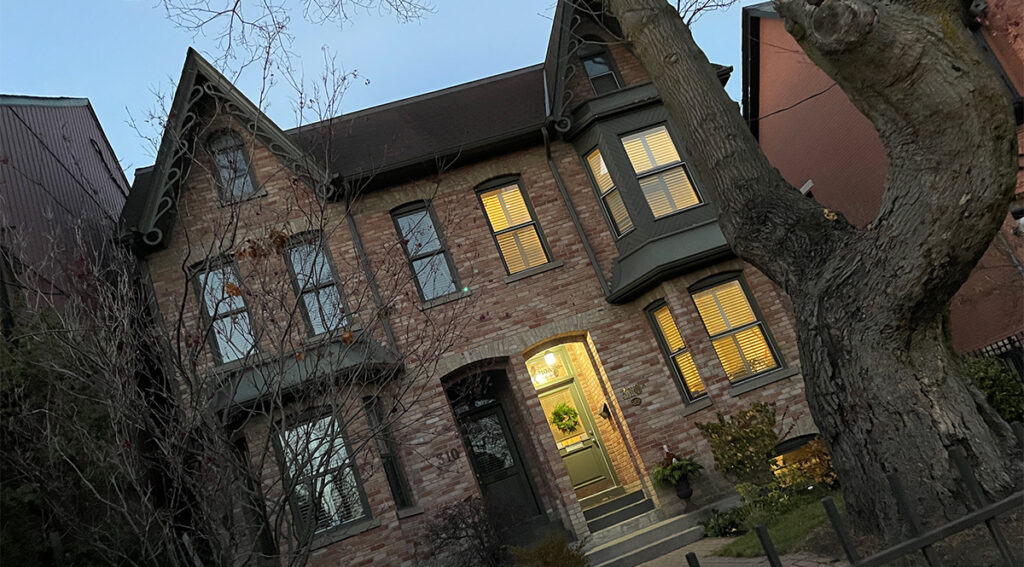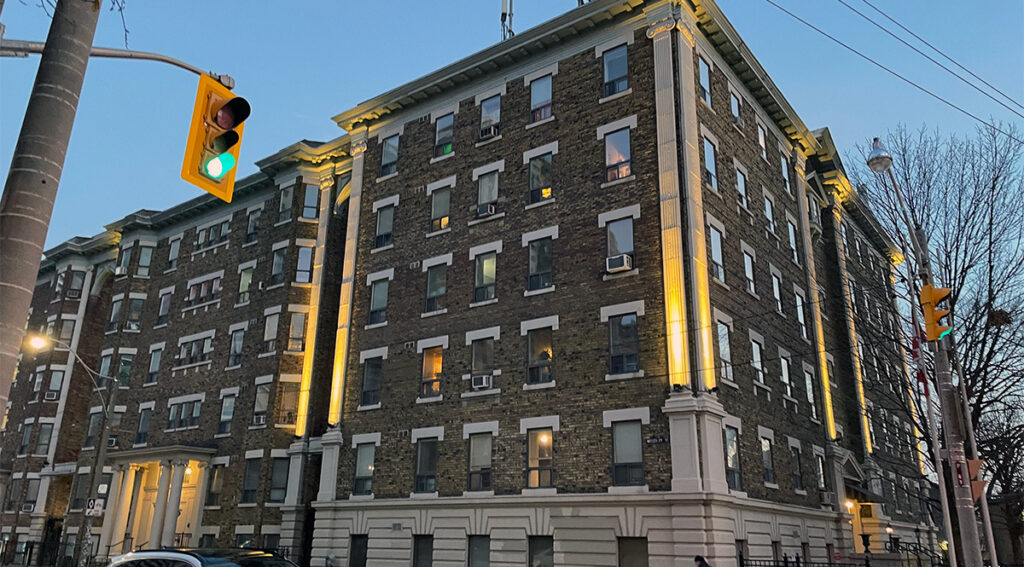A city’s subterranean secrets are fertile soil to grow urban legends.
Think of the alligators in the New York sewage system, arguably the most famous urban legend of them all. Toronto too has its share of urban legends, and many of them are set beneath the city’s streets. Some follow a familiar, ghost story format, like The Lady in Red, who drifts forlornly through the long-defunct Lower Bay Station, seemingly distraught and missing her feet, and by some reports, her eyes also.
Another claim is that a network of tunnels linked Old Fort York to the Wheatsheaf Tavern, Toronto’s oldest watering hole, located at King and Bathurst, allowing soldiers to leave their posts for a libation. The timing of the fort’s closing and the tavern’s opening casts doubt on this legend, but urban legends tend to be immune to these petty details.
Perhaps the most original, and most interesting urban legend centres in, around and beneath Toronto’s Cabbagetown neighbourhood.
Located on the eastern edge of what is considered downtown, Cabbagetown takes its name from the Irish immigrants who settled there in the 1840s and grew cabbage in the gardens. It boasts having the largest continuous area of preserved Victorian housing in North America.
As with any historic district in a major urban centre, Cabbagetown has undergone many changes with waves of immigration, economic highs and lows, the transformative nature of wars and new development after new development. But what lurks beneath this picturesque community whose brick walls and wrought iron fences tell the story of Toronto? Depending on who you ask, there might be a monster, a water spirit or even extraterrestrials.
An eyewitness account
On March 25, 1979, the Toronto Sun ran a story with the headline “Tunnel Monster of Cabbagetown,” by then-staff writer, now prominent columnist, member of the Canadian News Hall of Fame and Sun Editor Emeritus Lorrie Goldstein. The half-page article, which amounts to about two columns of copy, features a photo of the supposed tunnel’s entrance and an artist’s rendering of a primate-like creature with glowing, supernatural eyes.
It was a piece that hinged entirely on one eyewitness account, that of a 51-year-old Cabbagetown resident named Ernest, who withheld his surname for fear of ridicule. He hadn’t come forward and seemed not to be seeking attention. The press only became aware of the story after a “reliable contact,” who had been told the story by one of Ernest’s relatives, brought it to the Toronto Sun.
The encounter took place the previous August, an unusually hot summer, in between Ernest’s apartment building and the one beside it. Ernest was looking for a kitten that had gone missing from a litter he had been caring for. He entered a narrow crevasse at the base of a fire escape where he suspected the kitten may have wandered into.
Ernest mentioned hearing strange sounds emanating from the tunnel, describing them as “strange noises, like animals in pain.” However, this detail is buried toward the end of the story and is not necessarily the reason he thought to climb down into the tunnel in the first place, as has been asserted in later retellings of the encounter. Given the climb necessary to reach the tunnel, it might not have been possible for a casual passerby to hear sounds emanating from it.
Ernest described the tunnel as being pitch black. He only made it about ten feet in, when he saw something incredible in the beam of his flashlight.
“The eyes were orange and red, slanted … it was long and thin, almost like a monkey … three feet long, large teeth, weighing maybe 30 pounds with slate gray fur.”
His description, although incredible, does not go too far beyond what can be explained. Had he seen a discarded doll or toy? A raccoon? Under the right circumstances, it is easy to misidentify common sights, and a dark tunnel lit only by a 1970s flashlight might qualify as “the right circumstances.” The colouring of the eyes sounds like “eyeshine,” the glowing effect when light reflects off the tapetum lucidum, a layer of tissue in the eye of many vertebrates such as cats, raccoons and dogs. The colour of the fur also sounds like something that might be seen on a cat, raccoon or dog. Typically, eyeshine is not something encountered in primates, as most primates are diurnal. However, eyeshine is found in strepsirrhine primates, such as lemurs and lorisiforms, and is found in the nocturnal branches of the haplorhine primates, including tarsiers and owl monkeys.
But what happened next cannot be explained away quite so easily.
“It said, ‘Go away, go away,’ in a hissing voice. Then it took off down a tunnel off to the side,” according to Ernest’s account in The Sun. The fact that the creature could speak eliminates the possibility that it was either a known animal or what we might consider a cryptid, an animal as yet unknown to science.
“I got out of there as fast as I could,” Ernest told Goldstein. “I was shaking with fear.”
Sitting with his wife Barbara in their Cabbagetown apartment, Ernest relayed the story to The Sun’s Lorrie Goldstein. Both husband and wife tried to reassure the journalist of Ernest’s sobriety and his character.
“He was terrified when he came back to the apartment and he doesn’t scare easily,” Barbara told Goldstein.
According to Goldstein, who spoke to Ernest’s friends, relatives and neighbours, Ernest was a reasonable man. Further to checking on Ernest’s character, Goldstein accompanied him to investigate the tunnel itself. He described the site where the encounter occurred as follows:
“It is at the bottom of a narrow passage between the building where he (Ernest) lives and the one next door. The only way to reach the tunnel entrance is to clamber 15 feet down the wrong side of the fire escape, which had once served as an exit to the street but today simply leads to a narrow chamber with walls of four sides.”
Ernest and Goldstein climbed down to the narrow chamber where the encounter had taken place seven months earlier. The entrance to the tunnel, which Goldstein described as having “a slab of concrete” as an adit, was now partially sealed. The tunnel entrance collapsed sometime in the intervening winter, the concrete slab having fallen on one side. The entrance had become too small for an adult to enter.
An unnamed sewer worker interviewed for the story doubts that the tunnel connects to the system, suspecting that poor drainage caused the earth to erode beneath that section of concrete. Without access to the passage, there was no way of confirming how far it went or what it might connect to.

Cabbagetown boasts having the largest continuous area of preserved Victorian housing in North America.
Revisiting the Tunnel Monster story
Almost half a century after the story went to print, Lorrie Goldstein, now an elder statesman of Canadian journalism, acknowledges some surprise in his part in the creation of one of the city’s most enduring urban legends.
“I’m amazed it keeps coming up … 44 years later,” Goldstein said.
Goldstein, a cub reporter having joined the Sun a year before the Tunnel Monster story, had dug up the story himself, hearing about it from a contact of Ernest’s. Although The Sun didn’t typically cover stories of the cryptozoological or paranormal kind, the story was met with enthusiasm.
“The editors loved it. Gave it a front page throw with an artist’s depiction of the reported tunnel monster. I got some kidding around the newsroom, but nothing out of line, and no one questioned my credibility in reporting it.”
To this day, Goldstein has been true to his word, keeping Ernest’s full name and other details about him secret. Refusing to divulge any information that wasn’t provided in the original piece, Goldstein drove home his conviction that Ernest was reliable.
“Honest, salt-of-the-earth type. Remember, he didn’t want any publicity or money for his story. I contacted him and he was reluctant to talk … this was not a con man trying to sell me on a made-up story for money.”
It seems unlikely that either Goldstein or Ernest could have understood what longevity the story would have in the popular imagination. Residents of a city or region enjoy maintaining and sharing a localized urban legend, although the tale of the Cabbagetown Tunnel Monster doesn’t seem to have spread too far beyond the city limits, with certain notable exceptions.
“It was the strangest story I’ve worked on before, or since,” Goldstein said.
After the story ran in The Toronto Sun, Goldstein received lots of positive reader feedback. It drew a lot of attention and even The National Enquirer reached out to Goldstein about it. For Goldstein it was one-and-done. He did not pursue it further. He did, however, leave the door open for a follow-up, having asked Ernest “to stay in touch if he ever saw anything similar …”
“He did not contact me again,” Goldstein said.
Although the story only has one eyewitness, and we don’t even know that eyewitness’s identity, the story has managed to persist for almost half a century. Like a snowball rolling downhill, the story has grown larger as other elements have attached themselves to it.
Sewers, Satanists and Sasquatch
New facets were added to the legend, some exaggerations of the original details, others combined Indigenous mythology and extraterrestrials. An episode of Animal Planets’ Freaky Encounters aired a segment on the Tunnel Monster, complete with snarling animal sound effects, which claimed that “Toronto’s sewer department thoroughly inspected the city’s entire tunnel system out of fear that whatever was down there may go after children.” The segment goes on to claim people and pets have gone missing in and around Toronto’s tunnels. Famous local Satanist Salako Kalfou is interviewed and surmises that the creature itself collapsed the tunnel entrance and therefore could “tear a person into small pieces.”
Goldstein’s story provides no evidence that the tunnel connects to Toronto’s sewage system or a network of underground tunnels. An unnamed city employee stated that it’s “not probable” that the tunnel in question connected to the sewers, theorizing the poor drainage likely caused erosion underground, hollowing out the narrow passage. Still, Goldstein’s piece, and subsequent others written about the encounter, tie the small crevasse between apartment buildings to a larger, subterranean network. Goldstein’s atmospheric opening to his piece sums this up perfectly.
There’s an eerie city lying beneath the streets of Metro, a city none of us knows much about.
Ernest has been a visitor to that silent world of sewers, drainage pipes and the ruins under old houses, and the memory of what he saw there will haunt him for the rest of his life.
Was it a Memegwesi?
Cryptozoologists have suggested a link between the tunnel mentioned in the story and the numerous rivers and creeks in the city that have been diverted and covered over, Garrison Creek and Taddle Creek being two famous examples. The link between the two does not seem to be one to suggest a biological explanation for the creature witnessed by Ernest, but a supernatural one.
As is often the case, cryptozoology enthusiasts have sought a precedent for the Tunnel Monster in Indigenous culture and storytelling. Just as Bigfoot sightings were linked to Salish tales of wild men in the Pacific Northwest, the Tunnel Monster has been linked to the Memegwesi of Algonquian tradition.
The Memegwesi, as described in George M. Eberhart’s Mysterious Creatures: A Guide to Cryptozoology, are small, hairy beings that stay close to water and caverns. It is said that they speak in a high, nasal voice and are aquatic. The fact that so many of Toronto’s rivers were built over and now run underground has caused some to speculate that what Ernest encountered was one of these beings. The size of the creature, its fur and its voice certainly don’t contradict some features of the Memegwesi tales.
If something in the tunnel did speak to Ernest, the most likely candidate would be a human, perhaps a child, given its size. Although one shudders to think of a small child playing in the tunnels under the city, that is the most reasonable explanation.
The east end of Toronto has long been the epicentre of urban legends, especially legends about what goes on beneath the streets. Not far from the apartment building where Ernest witnessed the Tunnel Monster, there are rumours of an underground facility, perhaps even an underground base or city.

There is plenty of unique architecture in Cabbagetown, including the imposing Ernescliff at Sherbourne and Wellesley.
Thinking beyond the sewers
The 1990 publication “Underground Alien Bases,” written by a man claiming to have been a high-ranking member of the U.S. military but giving his name only as Commander X, asserts that there are extraterrestrial bases buried deep underground and that one of them happens to be beneath the intersection of Gerrard and Church Street.
The book describes “a small opening to the underground tunnels off Parliament Street in downtown Toronto.” Commander X depicts Ernest as having “accidentally discovered the cave system that networks under Toronto.” It is safe to assume that Commander X is borrowing heavily from Goldstein’s Tunnel Monster piece (omitting that the city worker interviewed in the Goldstein piece doubted whether that tunnel connected to the sewer system).
Commander X’s contribution to the lore continues, as his book claims that strange magnetic effects have been observed at Gerrard and Church, a result of strange happenings, and the generation of powerful electromagnetic fields underground. This phenomenon, Commander X claims, is responsible for “bizarre equipment failures” on the surface, leading to a disproportionate number of car accidents at that intersection. Recent lists of the intersections with the highest rates of accidents do not include Gerrard and Church.
Underground Alien Bases is just one of the books, along with titles such as The Great Lakes Triangle by Jay Gourly and Gateway to Oblivion by Hugh F. Cochrane that have helped cement the idea that the region in and around Lake Ontario is a hotbed of UFO activity and may house a base either beneath the lake or one of the surround areas. That UFO sightings have led to the idea of an underground base, and that that has coalesced with the Tunnel Monster story is not surprising. Just as some people seek corroboration from folktales and mythology to explain bizarre sightings, others mix and match sightings of anomalous phenomena, using one to corroborate another.
One might assume that Commander X is drawing the conclusion that the Tunnel Monster was an extraterrestrial biological entity, but his explanation might even be considered further afield. He not only asserts that there are underground UFO bases beneath Lake Ontario and in the surrounding areas populated by Greys, but he also claims that Deros exists beneath the city streets. Made famous from the writings of Richard S. Shaver, a “Dero” is an evil subterranean creature who seeks to torment surface-dwellers with advanced technology. Commander X describes encountering a Dero on the streets of Toronto at 4:00 am.
“One time I encountered one at 4:00 AM that had no face except for eyes and two holes in his blank face for a nose breathing area, no mouth at all,” Commander X wrote.
This first-hand encounter with a Dero on the streets of Toronto, for what it’s worth, is a more interesting addition to the Tunnel Monster story than just connecting the subterranean nature of the creature to the writings of Richard S. Shaver. Nonetheless, it demonstrates how these stories inevitably cross-pollinate with facets and details from other stories in the paranormal literature.
But does Commander X suggest that the creature Ernest allegedly encountered was a Dero? No, he claims that Ernest witnessed a “Sacred Tibetan Kadomma, the Guardian of the gateways to the Cities of Shamballa.”
If we take everything Ernest recounted as true, there really is no explanation for what he saw. It cannot fit neatly into any rational explanation or even the standard paranormal or cryptozoological forms. The Tunnel Monster defies any scientific or even pseudoscientific paradigm. Perhaps that’s why it is such an enduring story. The encounter conjures a fairytale element, that of a malformed creature lurking in the dark that can speak our language and shies from our gaze.
A child hiding, afraid that Ernest might give away their hiding spot seems like the likeliest explanation, assuming the encounter took place at all and was remotely similar to what was relayed. To disappear deeper in so dark a tunnel does not seem like a child playing a game, but someone hiding from an adult wishing to do them harm. That is all just a wild guess, yet far less “wild” than a water spirit, unknown animal, guardian of Shamballa or extraterrestrial. The only certainty is that the encounter, with whatever it was, has become a permanent part of the city’s lore and will likely endure long after Cabbagetown is unrecognizable from Ernest’s time.

